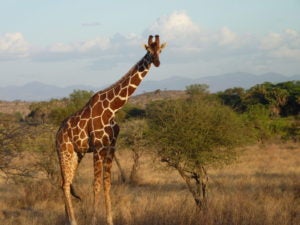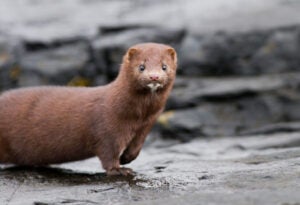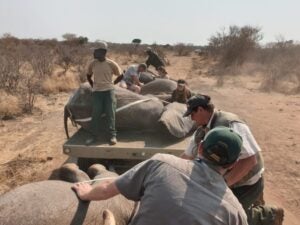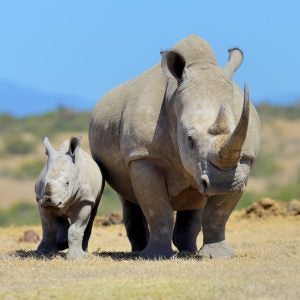Humane Society International / United Kingdom
Issue Type: Wildlife
Wildlife
Humane Society International

WASHINGTON— Conservation and animal protection groups today filed a notice of intent to sue the U.S. Fish and Wildlife Service for failing to consider Endangered Species Act protections for Africa’s rapidly dwindling giraffe population.
The groups Center for Biological Diversity, the Humane Society of the United States, Humane Society International and several others petitioned for giraffe protections in April 2017, but the species still has not received the legally required finding that was due in April 2018, nor any protection under the Act.
Last year, after a lawsuit filed by the groups, the U.S. Fish and Wildlife Service determined that giraffes may qualify for protections under the Act — but the agency has failed to make a decision or implement any protective measures.
“Giraffes are loved by people around the world, so it’s shocking and sad that the U.S. government is ignoring their tragic plight,” said Tanya Sanerib, international legal director at the Center for Biological Diversity. “As giraffe populations plummet, these extraordinary creatures desperately need the Endangered Species Act’s sturdy shield. But three years after we petitioned for protections, federal officials are still stalling on safeguards for everyone’s favorite longnecked mammal.”
With fewer than 69,000 mature individuals remaining in the wild, giraffes have been undergoing what has been called a silent extinction. Giraffe populations have dropped nearly 40% due to habitat loss, civil unrest and poaching and the international trade in bone carvings, skins and trophies puts additional pressure on these iconic animals.
“The United States has an important role to play in preventing extinction of these magnificent creatures, as the top importer of giraffe trophies, and as many Americans import giraffe parts — including bones and skins — to sell them for commercial purposes in the U.S.,” said Adam Peyman, wildlife programs director for Humane Society International, speaking on behalf of Humane Society International and the Humane Society of the United States. “The time has long passed for the Fish and Wildlife Service to take action and put in place desperately needed protections.”
Parties to the Convention on International Trade in Endangered Species (CITES) decided in 2019 to regulate international trade in giraffes — including trophies and other body parts — by placing the species on the Appendix II of the Convention. But several key exporting countries in Africa have expressed that they do not intend to implement or enforce CITES requirements with respect to giraffes even though the listing only requires export permits and reporting of international trade in giraffes. Protection under the Endangered Species Act is desperately needed to help curb imports of giraffe bones, trophies and other parts to the U.S. and increase funding for conservation efforts for the species.
On average, the U.S. imports more than one giraffe hunting trophy a day and imported more than 21,400 giraffe bone carvings between 2006 to 2015. Many of the imported giraffe parts are turned into frivolous decorative items such as pillows, boots, bible covers or jackets.
The International Union for the Conservation of Nature assessed giraffes as “vulnerable” to extinction in 2016 and classified two giraffe subspecies as “endangered” and two more as “critically endangered” in 2018.
Use of wild animals in traveling circuses and keeping and breeding of dolphins and killer whales in captivity also terminated.
Humane Society International / United Kingdom

LONDON—French minister Barbara Pompili has announced the end of mink fur farming in France. The country’s last four remaining fur farms will have to close no later than 2025, although campaigners at Humane Society International predict that their closure may come sooner. The announcement comes a month after an undercover investigation by French animal campaigners, One Voice, revealed shocking evidence of animal suffering on mink fur farms. The announcement also included many other sweeping animal welfare reforms adopted by the French government, such as ending the use of wild animals in traveling circuses and keeping and breeding dolphins and killer whales in captivity in marine parks.
According to Fur Europe (in 2018), France produced 100,000 mink skins on five farms, but recent public pressure against cruel fur farming practices has been a major driving force behind the ban. Latest opinion polls show that 77% of French citizens favour a ban on raising and slaughtering animals for their fur. More than half a million people in France have signed the referendum for the animals, which includes a ban on fur farms.
Although the mink fur farm ban does not impact France’s Orylag rabbit fur industry, it is nonetheless a significant sign of progress towards ending the trade. Orylag fur comes from genetically manipulated rabbits who are bred in deprived, factory farm style caging.
Claire Bass, executive director of Humane Society International/UK, said: “We applaud the French government for taking a stand against the immense suffering endured by mink for fur fashion. The shocking scenes showing paralysed mink displaying signs of severe distress at France’s last remaining fur farms, were enough to make the world shudder. So it is commendable that Minister Pompili has listened to the public outcry that this kind of cruelty is unacceptable. This mink fur farm ban is a great first step for France, and with mink fur production at an all-time low in France we predict and hope that these farms may close sooner than the 2025 deadline.
In the meantime, we urge the French government to also end the equally inexcusable suffering of Orylag rabbits who are farmed for fur in terrible conditions, and we call on the UK government to advance a ban on fur sales as soon as is practicable after the EU transition. For as long as the UK remains open for business to sell fur from countries overseas such as France, we are complicit in this cruelty.”
Across Europe, 13 countries have banned fur farming, Britain being the first to do so in 2003. One Voice has been urging the Ministry of Ecology since 2017 to publish a decree to shut down all mink operation in France. In support of their campaign, HSI/UK and other members of the Fur Free Alliance—an international coalition of more than fifty animal protection organisations—wrote a letter to the French Embassy asking for a ban.
Muriel Arnal, CEO of One Voice, said: “Finally, France has a mink fur farming ban. But alas it will not take effect for a long time compared to the mink fur farm ban just announced in the Netherlands. We will keep on fighting to close down these four farms before the deadline set by the ministry of Ecology.”
Fur facts:
- An estimated 60 million mink are farmed for their fur in 24 countries around the world, with the top three production countries China (20.6million mink), Denmark (17.6million mink) and Poland (5 million mink) in 2018.
- A 2020 YouGov opinion poll, commissioned by HSI/UK, reveals that 93% of the British population reject wearing real animal fur, and the majority (72%) support a ban on the sale of fur in the UK. The poll also demonstrates Brits’ scathing view of fur – the words that people most closely associate with a fashion brand selling fur are ‘unethical’, ‘outdated’, ‘cruel’ and ‘out of touch’.
- Across Europe, mink fur farms have been affected by outbreaks of COVID-19. In the Netherlands, 56 mink fur farms so far have been infected with the coronavirus, and outbreaks have also been documented on fur farms in Spain and Denmark, as well as in the United States.
- Fur farming has been banned across the UK since 2003, and has been prohibited and/or is in the process of being phased-out in Austria, Belgium, Bosnia-Herzegovina, Czech Republic, Croatia, Macedonia, the Netherlands, Norway, Luxembourg, Serbia, Slovakia, Slovenia, and most recently the government in Ireland has committed to ending fur farming.
- Bulgaria, Lithuania, Montenegro and Ukraine are also presently considering bans on fur farming and in Finland the majority party of the coalition government just announced its support for a ban on fur farms.
- In the United States, California became the first US state to ban fur sales in 2019 following similar bans in cities including Los Angeles, San Francisco, Berkeley and West Hollywood. In 2020, legislators in Hawaii and Rhode Island introduced fur sales ban proposals, as have cities in Minnesota and Massachusetts.
Download video from the latest French fur farm investigation
ENDS
Media contact: Leozette Roode: lroode@hsi.org; +27 71 360 1104
A bold elephant relocation and contraception exercise has seen Humane Society International place > 1040 female elephants on immunocontraceptive birth control.
Humane Society International / Africa (in South Africa)

CAPE TOWN— A wild herd of elephants that roamed in Limpopo’s Atherstone Game Reserve has been translocated by Global Supplies – Conservation Initiatives to a safe haven through the collaborative efforts of the Elephant Reintegration Trust, global animal welfare organisation Humane Society International-Africa (HSI-Africa) and Fondation Franz Weber, a Swiss organisation that has been dedicated to the protection of elephants since 1975.
At the same time, HSI-Africa treated the herd’s females with immunocontraception to humanely control the population growth at their new home.
Elephant immunocontraception – a non-steroidal, non-hormonal and humane method of elephant population control – has been researched and funded by HSI and the Humane Society of the United States since 1996. Immunocontraception uses the female elephant’s own immune response to block egg fertilisation.
Female elephants over the age of 10 years are darted remotely from a helicopter with a dropout dart that contains the immunocontraception vaccine and a marking dye. This marks the elephant at the dart site, creating a quick aerial reference of which animals have been darted. The dart falls out a short while afterwards. Thus, the animals do not need to be immobilised in order to be treated and the vaccinations are completed within minutes.
“This relocation marks the 36th population and 1041th female elephant on immunocontraceptive treatment to date. This is more than half of all breeding age female elephants in populations outside of the Kruger National Park.
“Considering that a female is capable of reproducing eight to 10 elephant calves within her lifespan, the exponential effect of our immunocontraception programme means that thousands of elephants have been spared from death through a cull as they compete for land and resources with people in an ever-shrinking habitat,” says HSI-Africa wildlife director, Audrey Delsink.
Smart elephant management
In addition to contracepting the females, HSI-Africa and partner Global Supplies – Conservation Initiatives also deployed a satellite tracking collar on one of the herd members to remotely monitor the elephants at their new home under the watchful eye of the Elephant Reintegration Trust. This translocation forms part of groundbreaking research into elephant behaviour and reintegration and is critical to our understanding of elephant management.
“The collaring and immunocontraception are part of a long-term, proactive elephant management strategy. Both activities work to save elephants’ lives and mitigate human-elephant conflict. We are extremely proud and excited to be part of this project that will not only lead to the enrichment of the lives of these elephants but will change the way in which we manage elephants in the future.
“We are delighted to collaborate with the Elephant Reintegration Trust, Fondation Franz Weber, who provided funding for the transportation of the elephants, and our partner, Global Supplies – Conservation Initiatives, as well as the progressive reserve that has willingly accepted this herd. We all share the same vision of peaceful human-animal co-existence,” added Delsink.
HSI-Africa is the only non-profit organisation that specifically works on humane methods of population management in and around reserves where elephants could come into conflict with surrounding communities.
ENDS
Media contact: Marisol Gutierrez, HSI-Africa media and communications manager, +27 72 358 9531, mgutierrez@hsi.org
Download photos of the elephant relocation
China is the world’s 2nd largest importer of rhino trophies after the U.S.
Humane Society International / China

BEIJING–China’s leading animal protection organizations have sent an open letter to President Xi Jinping urging the Chinese government to make China the first country in Asia to ban the import of rhino hunting trophies. At a press conference held in Beijing on World Rhino Day, Capital Animal Welfare Association (CAWA) together with wildlife and legal experts released the letter co-signed by more than twenty Chinese animal protection and conservation organizations as part of an appeal to eliminate Chinese demand for rhino products, including hunting trophies.
China is the world’s second largest importer of rhino hunting trophies after the United States. Between 2009 and 2018, China declared imports of 46 southern white rhino trophies – most imported from South Africa – in addition to 33 skins, eight bodies, 112 feet and six tails that also resulted from trophy hunts*. However, in a concerning discrepancy, South Africa reported exporting a total of 115 rhino horns and hunting trophies destined for China between 2013 and 2016 while China only reported importing 42 during the same period, raising suspicions of a vibrant black market for illegal rhino horns in China.
The Convention on International Trade in Endangered Species of Wild Fauna and Flora (CITES) has identified China as a “focus country” to address the rhino poaching crisis and rhino horn trafficking, in addition to Viet Nam, Zimbabwe, South Africa, Namibia, Botswana and Mozambique. Indeed, 30% of recorded global rhino horn seizures between 2014 and 2018 involved China, suggesting that demand for rhino horn in the country is increasing. The number of overseas Chinese nationals arrested for crimes involving illegal rhino horn has also escalated significantly in recent years.
The Chinese NGO and experts’ letter states: “Trophy hunting is a bloody hobby and has been heavily chastised by members of the public in most countries around the world. However, this activity has become a pursuit for the wealthy few in China who can afford to spend a large sum to travel across the globe and take pleasure from killing rare and iconic wild animals, showing off by posing for morbid selfies by the slain animal bodies. Our country has become the target of aggressive promotion by the international trophy hunting industry that has been losing customers in the West and hope to lure Chinese customers…The International Union of Conservation of Nature’s Ethics Specialist Group has stated that trophy hunting is unethical. Trophy hunting is deeply rooted in Western colonialism and incompatible with Chinese history and tradition.”
Citing recent CITES reports, CAWA and co-signers of the letter also raised their concerns about the continuous transnational trafficking of rhino horns from Africa by Chinese criminal networks. Enforcement investigations have found evidence of strong and persisting demand for rhino horns within China.
Madame Qin Xiaona, founder of CAWA, said: “With China implicated as a major destination of illegal rhino horns, the additional distinction of China as the world’s second largest importer of rhino trophies is a stain on China’s international conservation image and runs counter to President Xi’s ecological civilization agenda. China does not need this cruel trade that panders to the whims of an extremely small number of the rich but does lasting damage to wildlife and to China’s reputation. We urge President Xi to adopt a ban on the import of rhino parts and products including rhino hunting trophies, similar to the existing, historic ban on the import of elephant tusks and their products.”
International wildlife experts also leant their voice of support for ending global trade in rhino trophies. Audrey Delsink, wildlife director at Humane Society International-Africa based in South Africa, said, “We applaud the Chinese animal protection groups and experts in calling to protect rhinos from trophy hunting. Trophy hunting and poaching of rhinos places a higher value on dead rhino parts than on the living animal, leading to this iconic species being decimated in the wild. The Chinese government has the power to show world leadership in how to save the rhino.
Rhinos are synonymous with South Africa’s natural heritage, and as the range state with the most rhinos in the world and therefore one of the last vestiges of hope for the species, the South African government should be doing all it can to protect rhinos rather than promoting activities that exploit them.”
Teresa M. Telecky, Ph.D., vice president of HSI’s wildlife programs, adds: “Chinese animal advocates have seen through the pseudo-conservation claims of the global trophy hunting industry and are sending them a powerful message – rhinos should not be hunted for fun and for bragging rights. China already has a ban on the import of elephant tusks and their products, including elephant tusk hunting trophies, and conservation efforts would be by a similar ban on the import of rhino trophies. However, stopping trophy hunting of rhinos is not China’s task alone. The United States is the world’s largest importer of rhino trophies and also has a critical role to play in protecting the world’s remaining wild rhinos.”
ENDS
Media Contact:
- China: Jake Cao, Secretary General, Beijing Capital Animal Welfare Association: vshinemz@163.com
- USA: Dr Peter Li, China policy specialist, Humane Society International: pli@hsi.org
- U.K: Wendy Higgins, director of international media, Humane Society International: whiggins@hsi.org
Notes
* stats from analysis of trade database from the Convention on International Trade in Endangered Species of Wild Fauna and Flora.
Humane Society International / United Kingdom
After 10 years with the fur trade, Mike Moser realised he was ‘defending what is indefensible’ and regrets not leaving sooner
Humane Society International / United Kingdom

LONDON—Mike Moser, who resigned as CEO of the British Fur Trade Association in 2018 after a decade of defending the fur industry, has come out in support of a UK ban on fur sales because he no longer believes fur can be produced humanely. Moser is now publicly supporting the #FurFreeBritain campaign by animal charity Humane Society International/UK.
Moser also worked for the International Fur Federation from 2008 to 2015 during which time he visited fur farms on five continents.. He says it was coming home to his beloved Labrador Barney after visiting fur farms overseas that made him realise keeping foxes and raccoon dogs in wire cages barely bigger than they were was unacceptably cruel. His growing doubts solidified during TV and radio debates with HSI/UK’s executive director Claire Bass, during which he began to feel he was “defending the indefensible.”
Moser, who will address MPs and Ministers at a No Business In Fur virtual event for HSI/UK next week, says: “I spent ten years working for the fur trade, and in that time I visited fur farms across the globe so I’ve seen the reality of fur farming. Over time I realised that whatever soundbites we devised to reassure consumers, retailers and politicians, neither welfare regulations nor any industry certification scheme, would ever change the reality of these animals being stuck in tiny wire cages for their entire lives. I would come home to Barney my Labrador, who I loved dearly, and realise that he wasn’t that much different in size to some of the animals I saw languishing on fur farms, and the thought of him being treated like that was just unthinkable. I felt a complete hypocrite.
“On a number of occasions I was in media debates with Claire from Humane Society International, and my job was to counter her claims, but increasingly I found that I agreed more with their messages than I did my own. I no longer had the conviction that what I was doing was right – defending what is indefensible. One of my main regrets is that I didn’t leave earlier. After I resigned, I met with HSI to express my respect for how they conducted their campaign, and in conversation realised I shared many of their views. I agree fully that the fur trade is out of time.”
In the ten years that Mike Moser worked for the fur trade, he witnessed caging of mink, foxes and raccoon dogs in countries as diverse as Denmark and Finland, China, Russia, and Latvia. He says that regardless of the country of origin and any associated welfare regulations, the basic cage-based model of fur farming is systemically cruel.
Mr Moser says: “It is universally accepted that the ability to exhibit natural behaviour is a fundamental tenet of good animal welfare. It is disingenuous of the fur trade to claim that mink and foxes bred over generations are now domesticated. It is still the instinct of a fox to hunt, to play and to dig and of a mink to swim and hunt. But even IF that were true, our dogs and cats are domesticated but we wouldn’t dream of keeping them in those conditions, it’s just not right.”
Moser is now a part-time consultant for Humane Society International/UK, using his knowledge and experience to support the charity’s #FurFreeBritain campaign for a UK fur sales ban. In 2000, the UK announced a ban on fur farming in Britain but didn’t prevent the import and sale of fur from animals farmed overseas. Since the ban came into effect in 2003, almost £800m of fur has been imported into the UK from fur farms in France, Italy, Poland, China and other countries. In 2018 almost £75m of animal fur was imported into the UK, based on pelt auction prices HSI UK estimates that this equates to some 2-3 million animals.
Mike Moser says: “The fur trade is anachronistic. It still fails to recognise that social attitudes towards animals have changed dramatically, that we understand much more clearly sentiency and what constitutes good welfare. The Zeitgeist today is that caging and killing animals for an unnecessary fashion product, that has only vanity value, is unacceptable. The UK banned fur farming two decades ago but for as long as we import and sell the fur from overseas, the UK is still supporting fur farming and trapping by proxy. That’s morally and politically ambiguous, and that’s why I support a UK fur sales ban.”
A new YouGov opinion poll, commissioned by animal charity Humane Society International/UK, reveals that 93% of the British population never worn fur, or no longer wear it, and the majority (72%) support a ban on the sale of fur in the UK.
Claire Bass, executive director of Humane Society International/UK, said: “British people and politicians take pride in being a nation of animal lovers, and so it doesn’t surprise me that it was Mike’s love for his dog Barney that was at the heart of his epiphany that caging and killing animals for their fur is wrong. If the idea of locking a pet dog in a cage for life and then electrocuting and skinning that animal for fur is unthinkable, then it’s not a big leap to feel similar empathy for animals like foxes who endure this cruelty on fur farms. I fully respect Mike’s change of heart, and he now has an important and powerful message for the UK government — if someone like him with a decade’s experience inside the fur industry says it’s right to ban fur sales, then it’s time to take action and end the suffering.”
An Early Day Motion 267 urging the government to introduce legislation banning the import and sale of real fur products has so far been signed by 126 MPs, including Tracey Crouch, Maria Eagle, Dr Lisa Cameron and Tim Farron.
Fur facts:
- More than 100 million animals are killed for their fur every year worldwide including mink, fox, raccoon dog, chinchilla and coyote – that’s equal to three animals dying every second, just for their fur. Rabbits are also killed for their fur, likely to be in the hundreds of millions.
- Fur comes with a hefty environmental price tag. Whilst all materials have some eco-footprint, when compared to other textiles, fur takes a significant toll in terms of the C02 emissions associated with keeping and feeding tens of thousands of carnivorous animals on a farm, the manure runoff into lakes and rivers, and the chemicals such as chromium and formaldehyde used to preserve the fur and skin to stop it from rotting.
- An increasing number of fashion designers and retailers are dropping fur cruelty. In the last few years alone Prada, Gucci, Armani, Versace, Michael Kors, Jimmy Choo, DKNY, Burberry, Chanel and other high-profile brands have announced fur-free policies. In addition, online fashion retail platforms Net-A-Porter and Farfetch have introduced no-fur policies.
Sign the #FurFreeBritain petition
Download fur farm photos and video
ENDS
Media contact: Leozette Roode, HSI/UK Media and Campaigns Manager, email: Lroode@hsi.org telephone: 00 27 713601104
Notes to the editor:
All figures, unless otherwise stated, are from YouGov Plc. Total sample size was 1,682 adults. Fieldwork was undertaken between 4th – 5th March 2020. The survey was carried out online. The figures have been weighted and are representative of all GB adults (aged 18+).
Early closure will spare 13.5 million mink from being born to suffer wasted lives
Humane Society International / Europe

AMSTERDAM—The Dutch government has agreed that all mink fur farms must permanently close by March 2021, according to Dutch national news service, NOS. Mink fur farming was banned in the Netherlands in 2013 with a deadline for complete phase out by 2024, so this decision sees that closure fast-tracked to prevent long term COVID-19 virus reservoirs forming on affected farms.
Since April, an estimated 2 million mink have already been preventatively culled following the outbreak of coronavirus on 41 fur farms. Leading animal charity Humane Society International applauds the Dutch cabinet for ordering the early closure of fur farms in the Netherlands and closing this chapter on this animal abuse industry.
Today’s announcement will not require mink on the 120 remaining fur farms to be preventatively culled unless new COVID-19 outbreaks occur. Mink on unaffected farms will be slaughtered for their pelts in November this year, but breeders are not permitted to restock, meaning fur farms will close forever. By March 2021, all remaining mink operations will be bought out by the government.
Speaking from Amsterdam, Dr Joanna Swabe, senior director of public affairs for Humane Society International/Europe, said: “This signals the end of suffering for millions of animals confined to small wire cages on fur farms in the Netherlands. We commend the government on its decision to end this incredibly cruel and completely unnecessary industry and protect citizens. With 41 fur farms and an estimated 2 million mink now having been infected, the risk of keeping these virus reservoirs operating, is far too great. Over the past weeks, the Dutch government has failed to act as infection numbers rose. Without this early termination of fur farming, up to 13.5 million more animals would be forced to suffer short and miserable lives solely to supply the fickle fashion industry. It is a sick industry both literally and figuratively. There has never been a more compelling time for the Netherlands to shut down this industry for good”.
Last month, the Dutch Government announced its plans to implement a one-stop voluntary closing scheme that allows mink companies to voluntarily end their business operations in the short term. It requested advice from the Outbreak Management Team on Zoonosis (OMT-Z) and promised to announce its decision on future steps in August 2020. Ministers Hugo de Jonge of Health, Welfare and Sport, and Carola Schouten of Agriculture, Nature and Food Quality, together with the fur farming sector and experts, tightened the hygiene protocol since 10 July in hopes of putting the spread to bed. However, following the news of further infections, the OMT-Z was asked to elaborate on the risk assessment and measures in the light of public health. Over the course of the next months, until the termination is fully implemented, Minister Schouten will tighten up COVID-19 measures on existing operations. She will also conduct an investigation into compliance with the COVID-19 rules by the sector.
The Netherlands farmed around 4.5 million mink in 2018. Since April, two fur farm workers are believed “extremely likely” to have contracted the virus from mink.
Mink fur farms and COVID-19 timeline
- 26 April: SARS-CoV-2 identified on two mink farms in Netherlands.
- 9 May: SARS-CoV-2 found on two more mink farms in Noord Brabant as well as in dust particles in the barns in which they are kept in.
- 15 May: SARS-CoV-2 diagnosed in three cats living at a mink farm where the presence of the virus was detected.
- 19 May: First farm worker reported to have contracted COVID-19; Minister confirms compulsory screening is extended to all mink farms in the Netherlands.
- 20 May: Dutch Agriculture Minister Carola Schouten tells MPs it is likely mink infected with SARS-CoV-2 passed the virus to a worker.
- 22 May 2020: Seven of 14 employees of a mink farm in La Puebla de Valverde (Spain) test positive for SARS-CoV-2.
- 25 May: A second farm worker contracts COVID-19, Minister confirms transmission from mink to humans now “extremely likely.”
- 28 May: Ministers’ confirm mandatory screening of all Dutch mink farms is underway.
- 1 June: SARS-Cov-2 found on another three mink fur farms in the Netherlands, with a fourth case confirmed on 3 June bringing the total to nine farms.
- 3 June: Dutch Ministers publish final report confirming animals on the infected farms will be culled, a measure taken “in the interests of both public and animal health”.
- 23 June: Dutch Parliament votes in favour of shutting down all mink fur farms in the Netherlands, with early closure of farms with compensation to be paid to fur farmers to end the practice earlier than the phase out due date of 31st December 2023.
- 1 July: The Dutch Government says it will consider a one-stop voluntary closing scheme and breeding ban for mink fur farms in the Netherlands. It aims to make a decision in August 2020 and must notify Parliament before the new mating season starts in February 2021.
- 6 July: 20th mink fur farm in the Netherlands confirmed with COVID-19
- 9 July: Two more mink farms in the Netherlands confirmed with COVID-19. Another 75,000 mink culled.
- 9 July: Brabant-Zuidoost regional safety board calls on Minister Schouten to implement preventative clearing.
- 13 July: The 23rd mink fur farm in the Netherlands was confirmed as being infected with COVID-19.
- 15 July: Another Dutch mink fur farm infected with COVID-19. This brings the total of infected farms to 24. The Dutch mink death toll reaches 1 million mink, according to national media sources.
- 16 July: First farm in Spain identified with corona-infected mink. The Aragonese Minister of Agriculture, Joaquín Olona, during the press conference in which he reported the extermination of the farm with 92,700 minks Health orders to exterminate a farm of 92,700 minks invaded by the Covid in Teruel. The authorities recognize that there are indications that point to a cross contagion between humans and animals on that farm.
- 10 August 2020: 28th and 29th farm confirmed by Ministers, in Elsendorp (12,000 dams) and in Vredepeel (6,000 dams) respectively.
- 13 August 2020: 30th farm confirmed by Ministers, in Ven-Zelderheide (municipality of Gennep), with approximately 1,800 mother animals.
- 14 August 2020: 31st farm confirmed by Ministers, in Altforst (municipality of West Maas en Waal), with approximately 12,000 mother animals.
- 14 August 2020: Forth farm identified in Denmark. All four farms identified are located in North Jutland. No details of the number of mink on the farm. The mink will not be killed.
- 16 August 2020: Infections on Netherlands farms 32 and 33 confirmed by Ministers, in De Mortel and in Ottersum.
- 17 August 2020: USDA Confirms first confirmed cases of SARS-CoV-2 in mink at two farms in Utah, United States.
- 18 August 2020: Three new Dutch farms confirmed, taking the total number of farms to 36.
- 24 August 2020: Three new farm infected with Covid-19. An infection with SARS-CoV-2 has been established on a farm in De Rips, as well as in Vlierden and in Ven-Zelderheide. A total of 40 mink farms in the Netherlands have now been declared infected.
- 27 August 2020: 41st farm infected with Covid-19.
- 27 August 2020: Dutch government announce agreement to fast track the permanent closure of all mink fur farms in the Netherlands by March 2021.
Media contact:
To request an interview with HSI spokespeople (Dutch and English speakers) please contact Leozette Roode, HSI/UK: LRoode@hsi.org
Notes
Latest available figures show approximately 35 million mink were farmed in 2018 in Europe, including Denmark (17.6m), Poland (5m), Netherlands (4.5m), Finland (1.85m), Greece (1.2m) and Lithuania (1.2m). Figures for the same period show that mink were farmed for their fur in China (20.7m), the United States (3.1m) and Canada (1.7m), bringing the total to approximately 60million mink globally on fur farms.
Decision should ban U.S. sales of world’s most trafficked mammal
Humane Society International / United States

WASHINGTON—Under a new legal agreement, the U.S. Fish and Wildlife Service will decide whether pangolins, the world’s most trafficked mammals, should be protected under the U.S. Endangered Species Act.
The agreement, approved today by a federal judge, requires the agency to decide by June 2021. It responds to a petition and subsequent lawsuit filed by conservation groups to force the government to make a decision on pangolins and ultimately ensure the United States fully bans pangolin trade.
Pangolins, the world’s only scaly mammal, inhabit Asia and Africa. Pangolins are in grave danger of extinction. Their scales are in high demand in traditional Chinese medicine, and their meat is consumed as a delicacy in some Asian countries.
“It’s a relief to see the U.S. stepping up to protect these unique creatures from the international wildlife trade,” said Sarah Uhlemann, international program director at the Center for Biological Diversity. “Pangolins are on the razor’s edge of extinction, and we have to do our part to save these odd but charming animals. Listing pangolins as endangered would zero-out the U.S. market.”
Between 2004 and 2014, more than a million pangolins were illegally traded—an average of nearly 300 animals killed per day. Despite a 2017 ban on international commercial trade in pangolins, illegal trade has continued and likely increased: the largest seizure ever occurred in Singapore in 2019, representing tens of thousands of dead pangolins.
“We are pleased that the U.S. has committed to taking these long-overdue steps to protect pangolins, which remain mostly unprotected under the Endangered Species Act despite being pushed to the brink of extinction by poachers,” said Adam Peyman, wildlife programs and operations manager for Humane Society International. “Listing will strengthen the nation’s capacity to combat the domestic market for pangolin products, which contributes to poaching and trafficking worldwide.”
While most illegally sourced pangolins are destined for markets in China and Vietnam, a U.S. market remains. Authorities seized least 26,000 imports of pangolin products in the United States between 2004 and 2013, and a 2015 report by Humane Society International found “medicinal” products containing or likely to contain pangolin parts openly for sale online and at U.S. stores.
“For the last half decade, we have been fighting for increased protections for pangolins and urging the U.S. government to take action and responsibility. We’re pleased to see the light at the end of this tunnel. The Endangered Species Act is the strongest tool we have to stave off extinction of our most imperiled species. As the world’s most trafficked mammal, it’s past time pangolins were protected by this bedrock law,” said Angela Grimes, CEO of Born Free USA.
One pangolin species, the Temminck’s ground pangolin, is already protected under the U.S. Endangered Species Act. Under today’s agreement, the Fish and Wildlife Service commits to decide whether the other seven pangolin species should be treated as endangered by June 2021.
“The United States must not be complicit in the brazen trade of these innocent animals,” said Zak Smith, director of international wildlife conservation at the Natural Resources Defense Council. “As pangolins face extinction in the midst of a global biodiversity crisis, this is an important step. But to increase the pangolins’ chance of survival, the agency must follow the science and law, and ultimately grant pangolins protection under the Endangered Species Act.”
If pangolins are protected as endangered, the law bans import and interstate sale of pangolin parts in the United States, except for scientific or other conservation purposes. Listing would also heighten global awareness about pangolins and the threats they face and make funding available for anti-trafficking and habitat conservation efforts.
ENDS
Media contacts:
Nancy Hwa, Humane Society International and the Humane Society of the United States, (202) 596-0808, nhwa@hsi.org
Sarah Uhlemann, Center for Biological Diversity, (206) 327-2344, suhlemann@biologicaldiversity.org
Karen Lauria, Born Free USA, (917) 783-3480, karen@bornfreeusa.org
Daniela Arellano, NRDC, (310) 434-2304, darellano@nrdc.org
World Elephant Day is a reminder that peaceful coexistence with this imperiled species is possible and necessary
Humane Society International / South Africa

CAPE TOWN—This World Elephant Day, Humane Society International/Africa is celebrating the treatment of its 34th population of African elephants using the immunocontraception vaccine as a humane population growth control method. This brings the total number of females under treatment in South Africa to 1,035 – which is more than half of all breeding-age female elephants outside of the Kruger National Park, which does not use contraception.
As an effective alternative to the traditional method of culling – when family groups are gunned down – immunocontraception uses the female elephant’s own immune response to block egg fertilisation. Female elephants over the age of 10 years are treated remotely from a helicopter with a dart that contains the immunocontraception vaccine and a marking substance.that creates a quick reference of which animals have been darted. The dart falls out shortly afterwards. The animals do not need to be immobilised to be treated and vaccinations are completed within minutes.
Download photos and video of elephants receiving the immunocontraception vaccine.
“Shooting these magnificent animals to control their numbers is an antiquated, cruel and unnecessary way to deal with an elephant population that is increasingly squeezed by human encroachment. Immunocontraception is the future of humane elephant conservation,” said Audrey Delsink, wildlife director for HSI/Africa and an elephant biologist.
“Elephants are widely acknowledged as highly cognitive, sentient beings with close-knit family bonds that span generations. It has also been well documented that these sensitive animals suffer symptoms of post-traumatic stress for decades after undergoing traumatic experiences such as capture from the wild, culling or poaching,” said Delsink.
Humane Society International and the Humane Society of the United States have funded cutting-edge research on the use of this non-steroidal, non-hormonal and humane method of elephant population control since 1996. HSI adopts a science-based approach, and with its research partners, has published numerous scientific papers documenting the vaccine’s efficacy, reversibility, lack of behavioural side effects and cost-effectiveness.
“African elephants face many challenges, particularly habitat loss,” added Delsink. “The past three decades have seen their habitat shrink by half, which also leads to increased opportunities for human-elephant conflict on the fringes of neighbouring rural communities, parks and reserves.”
HSI/Africa is working to protect elephants from these and other threats through advocacy, education, policy and regulatory reforms, ivory-demand reduction programmes and on-the-ground conflict resolution efforts. It is the only non-governmental organisation that specifically works on humane methods of birth control in and around zones where elephants could come into conflict with surrounding communities.
With natural processes such as elephant migration curtailed by fences and borders and elephants limited to smaller areas, the ecosystem within the animals’ range also needs to be carefully managed. With females able to produce eight to 10 calves in their lifetime, elephant populations are able to double every 10 to 15 years, making immunocontraception a vital tool in elephant management plans.
Boys will be … bulls
Young male or bull elephants are sometimes incorrectly labelled as ‘problem’ or ‘damage-causing’ animals because they do what they are biologically programmed to do: to seek out new territory after leaving their natal herd. In the process, conflict with people can occur and the animals may be legally destroyed.
To mitigate such conflict in a community in rural KwaZulu-Natal, HSI/Africa and partners Global Supplies and Conservation Outcomes recently deployed three satellite collars on two bulls and a member of a family herd. The collars facilitate the remote monitoring of the animals’ movements: when a collared elephant nears a defined perimeter, reserve management are alerted and can then take steps to reduce the chance of conflict.
This is the second community reserve in the province where the partnership has deployed immunocontraception and satellite collars, embracing science and technology to provide more humane solutions that allow people and elephants to peacefully co-exist.
Download photos and video of elephants receiving the immunocontraception vaccine.
ENDS
Media contact: Marisol Gutierrez, HSI/Africa media and communications manager, +27 72 358 9531, mgutierrez@hsi.org
